Ion Channel Screening Assays
Background
Ion channels play a critical role in regulating a wide array of physiological processes, including rapid electrical signaling, fluid and electrolyte balance, hormone and neurotransmitter secretion, and cell proliferation. Due to their essential functions, ion channels are common targets for both therapeutic agents and natural toxins. In addition to their significance in drug development, ion channels are also key indicators in drug safety evaluation.
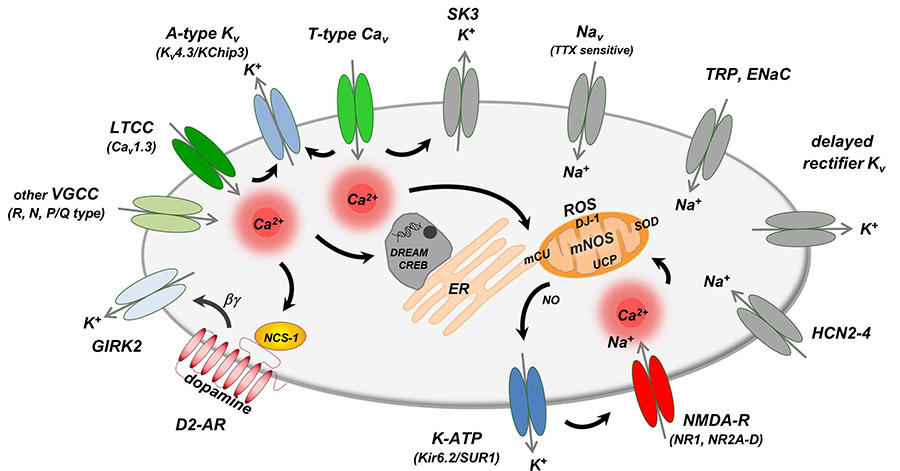
Figure 1. Distinct ion channels in substantia nigra dopamine neurons. (Dragicevic et al., 2014)
Creative BioMart offers a comprehensive portfolio of Ion Channel Assays designed to deliver fast, accurate results for drug discovery and development. All assays are developed in accordance with internationally recognized standards to ensure reliability and reproducibility.
What We Offer?
Our ion channel portfolio includes over a hundred well-characterized channels, systematically categorized into functional panels based on the latest scientific and clinical insights. To support comprehensive profiling and risk assessment, Creative BioMart offers both manual and automated screening platforms with customizable parameters tailored to the diverse needs of modern drug discovery.
-
Customizable Screening Parameters
At Creative BioMart, we recognize that each research project has unique requirements. Our ion channel screening assays are designed with flexibility in mind, allowing researchers to tailor experimental conditions to their specific needs. This customization ensures optimal assay performance and data relevance.
-
Available Channel Panels
Ion channels are integral to numerous physiological processes, and their dysfunction is implicated in a wide array of diseases. To address this, Creative BioMart offers a comprehensive suite of ion channel panels tailored to specific therapeutic areas, facilitating targeted drug discovery and development.
-
Target Channel Expertise
Our extensive experience encompasses a broad spectrum of ion channel targets, ensuring precise and reliable screening outcomes. We specialize in both voltage-gated and ligand-gated channels, which are pivotal in various physiological and pathological processes.
-
Assay Platforms & Technologies
To accommodate diverse research needs, Creative BioMart employs a range of advanced assay platforms and technologies. These methodologies are selected based on the specific requirements of each project, balancing throughput, sensitivity, and physiological relevance.
Service Highlights
Creative BioMart provides a wide range of ion channel assays to quickly and accurately provide results for drug discovery and development. Our assays are established based on globally recognized standards.
|
Service |
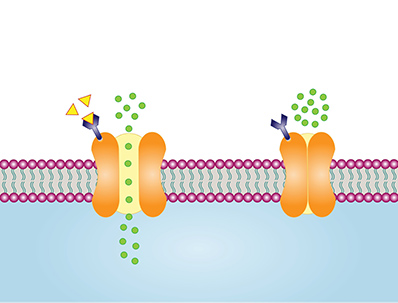 Ion Channel Binding Assay |
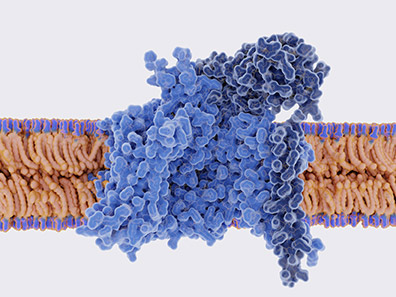 Ion Channel Profiling |
 Cardiac Safety Assay |
 |
|
Overview |
Assesses molecular interactions between compounds and ion channels using radioligand, fluorescence, or SPR methods. |
Evaluates the activity of compounds across a broad panel of ion channels to determine selectivity and off-target effects. |
In vitro evaluation of potential cardiotoxicity using ion channels like hERG, Nav1.5, and Cav1.2, aligned with CiPA guidelines. |
Creation of stable or inducible cell lines expressing specific ion channels, engineered for screening and research. |
|
Key Capabilities |
|
|
|
|
|
Applications |
|
|
|
|
|
Custom Options |
|
|
|
|
|
Deliverables |
|
|
|
|
Why Choose Us?
- Broad Channel Coverage: We offer assays for over 100 ion channels, including sodium, potassium, calcium, chloride, voltage-gated, and ligand-gated targets.
- Diverse Assay Platforms: Choose from manual/automated electrophysiology, ion flux, and fluorescence-based assays depending on your desired throughput and physiological relevance.
- Highly Customizable: We tailor assay conditions—including ion channel type, stimulation protocols, and readouts—to meet each client's specific research objectives and compound profiles.
- High Throughput: Our advanced platforms enable rapid screening of thousands of compounds, accelerating hit identification and reducing early-stage development timelines.
- Fast Turnaround Time: Streamlined workflows, automated systems, and expert staff allow us to deliver reliable screening data within tight project deadlines.
- Over 10 Years of Experience: With a decade of hands-on expertise, we’ve supported ion channel projects across CNS, cardiovascular, oncology, and rare disease indications.
Case Study
* NOTE: We prioritize confidentiality to safeguard our clients’ technology and intellectual property. As an alternative, we present selected published research articles as representative case studies. For details on the assay services and products used in these studies, please refer to the relevant sections of the cited literature.
Case 1: Voltage-gated sodium channel Nav1.5 promotes tumor progression and enhances chemosensitivity to 5-fluorouracil in colorectal cancer
Sui et al., 2020. doi:10.1016/j.canlet.2020.12.017
Nav1.5, encoded by SCN5A, was found to drive tumor progression and metastasis in colorectal cancer (CRC). High SCN5A expression correlated with poor prognosis but also indicated better response to 5-FU chemotherapy in stage II/III patients. In vitro, SCN5A knockdown reduced CRC cell growth, migration, and invasion, and suppressed cell cycle and EMT pathways. Mechanistically, Nav1.5 enhanced Ras signaling through Ca2+/calmodulin interactions. Interestingly, while SCN5A knockdown increased resistance to 5-FU, it also heightened apoptosis. These findings suggest Nav1.5 as both a prognostic marker and a predictor of 5-FU sensitivity in CRC.
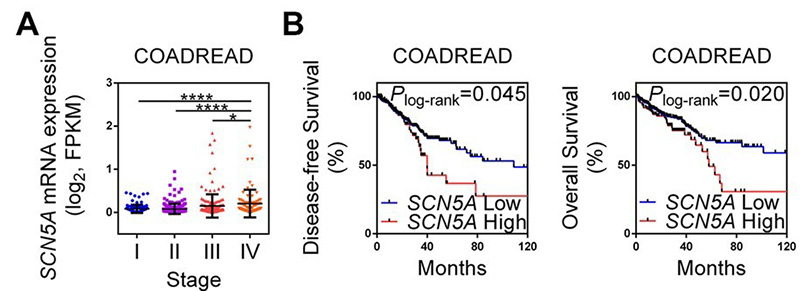
Figure 2. Elevated SCN5A was correlated with poor prognosis but was associated with better survival after 5-FU chemo therapy in CRCs. (A) Data on SCN5A expression were obtained from the TCGA COADREAD database and were compared between stage IV CRCs and stage I-III disease. (B) Disease-free survival and overall survival were compared between the high and low SCN5A expression groups. (Sui et al., 2020)
Case 2: Selective regulation of human TRAAK channels by biologically active phospholipids
Schrecke et al., 2020. doi:10.1038/s41589-020-00659-5
TRAAK, a member of the two-pore domain potassium (K2P) channel family, plays a key role in maintaining resting membrane potential and enabling rapid action potential conduction. Although regulated by various stimuli, its lipid-binding preferences remain unclear. This study reveals that K2P4.1 isoforms show distinct affinities for lipids based on acyl chain characteristics and SN1 linkages. Among 33 lipids tested, phosphatidic acid showed the strongest binding and effectively activated the channel in a dose-dependent manner. These findings shed light on the molecular basis of lipid recognition by K2P4.1.
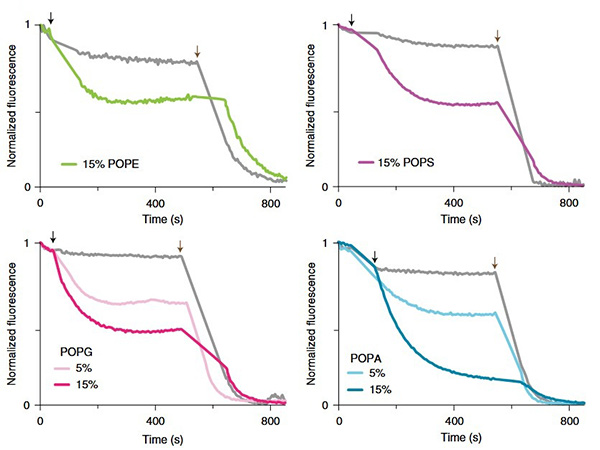
Figure 3. Liposome potassium flux assays of K2P4.1a reconstituted in defined lipid environments. Flux assay traces for K2P4.1a reconstituted in POPC doped with POPG, POPS, POPE or POPA. Empty liposomes of the same lipid composition are shown in gray. The addition of the proton ionophore CCCP and the potassium ionophore valinomycin is denoted by black and brown arrows, respectively. (Schrecke et al., 2020)
Customer Testimonials
-
“Creative BioMart delivered high-quality ion channel profiling data ahead of schedule, helping us meet a critical go/no-go milestone in our CNS program. The report provided clear insights into sodium and potassium channel selectivity, which were essential for our IND-enabling studies.”
— Director of Pharmacology | Neuroscience Biotech Company
-
“We utilized Creative BioMart’s automated electrophysiology platform to assess compound effects on key cardiac ion channels. Their Nav1.5 and hERG data flagged early safety concerns, helping us avoid costly downstream failures. Their responsiveness and scientific guidance were top-notch.”
— Head of Preclinical Development | Global Pharmaceutical Company
-
“Their team customized ligand-gated ion channel assays to support our screening of a novel GABA-A modulator. The combination of manual patch-clamp and high-throughput fluorescence assays significantly accelerated our lead optimization—saving us at least three months in development.”
— Senior Scientist | CNS-Focused Drug Discovery Startup
-
“We outsourced TRP channel ion flux assays for our pain and inflammation program. The data were reproducible and highly sensitive, and Creative BioMart’s team was able to run the assays under variable temperature and pH conditions to simulate disease-relevant environments.”
— Group Leader | Inflammation Research Division of a Mid-Sized Biotech
-
“Creative BioMart’s panel-based ion channel screening gave us valuable insight into target engagement across oncology and cardiovascular indications. Their flexible service and consistent data quality made them a preferred partner for our early discovery work.”
— VP of Discovery Research | Therapeutic Antibody Development Company
FAQs
-
Q: What types of ion channels can you screen?
A: We offer assays for a wide range of ion channels, including sodium, potassium, calcium, chloride, voltage-gated, and ligand-gated channels. Our portfolio includes over 100 targets, organized into disease-relevant panels to support both early discovery and safety profiling. -
Q: What assay platforms do you use for ion channel screening?
A: We utilize multiple assay platforms including manual electrophysiology, automated patch-clamp systems, ion flux assays, fluorescence-based readouts, and high-throughput screening technologies. This allows us to balance physiological relevance, data richness, and screening speed. -
Q: Do you offer cardiac safety screening for early risk assessment?
A: Yes. Our cardiac safety panel includes critical ion channels such as hERG and Nav1.5. These assays help predict potential cardiotoxicity and support regulatory safety evaluations. -
Q: Can you customize assay conditions to meet our project needs?
A: Yes. Every assay we run is highly customizable. We can adjust perfusion time, temperature, concentration ranges, and stimulation protocols to align with your specific compounds and experimental objectives. -
Q: What is your typical turnaround time for ion channel screening projects?
A: Timelines vary by project scope, but our streamlined processes and automation allow us to deliver high-quality data within 2–4 weeks for most standard screens.
-
Q: How do you ensure data quality and reproducibility?
A: With over 10 years of experience, we follow globally recognized assay standards, use validated protocols, and apply rigorous quality controls to ensure that your results are robust, reliable, and publication-ready.
-
Q: Can you support high-throughput compound libraries?
A: Absolutely. Our screening platforms are designed for high-throughput applications and can handle large compound libraries while maintaining speed and data integrity.
Resources
Related Services
Related Products
References:
- Dragicevic E, Schiemann J, Liss B. Dopamine midbrain neurons in health and Parkinson’s disease: Emerging roles of voltage-gated calcium channels and ATP-sensitive potassium channels. Neuroscience. 2015;284:798-814. doi:10.1016/j.neuroscience.2014.10.037
- Schrecke S, Zhu Y, McCabe JW, et al. Selective regulation of human TRAAK channels by biologically active phospholipids. Nat Chem Biol. 2021;17(1):89-95. doi:10.1038/s41589-020-00659-5
- Sui Q, Peng J, Han K, et al. Voltage-gated sodium channel Nav1.5 promotes tumor progression and enhances chemosensitivity to 5-fluorouracil in colorectal cancer. Cancer Letters. 2021;500:119-131. doi:10.1016/j.canlet.2020.12.017
Contact us or send an email at for project quotations and more detailed information.
Quick Links
-

Papers’ PMID to Obtain Coupon
Submit Now -

Refer Friends & New Lab Start-up Promotions

